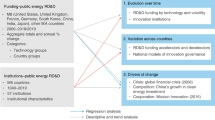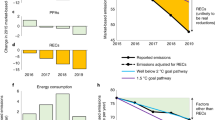Abstract
The mix of public and private funding in alternative energy research makes isolating the effect of government funding challenging. Factors such as energy prices and environmental policy influence both private and public R&D decisions, and it may take several years for public R&D’s effect on technology to be realized. Here, by combining data on scientific publications for alternative energy technologies with data on government R&D support, I provide information on the lags between research funding and new publications and link these articles to citations in US energy patents. I find that US$1 million in additional government funding leads to one to two additional publications, but with lags as long as ten years between initial funding and publication. Finally, I show that adjustment costs associated with large increases in research funding are of little concern at current levels of public energy R&D support. These results suggest that there is room to expand public R&D budgets for renewable energy, but that the impact of any such expansion may not be realized for some time.
This is a preview of subscription content, access via your institution
Access options
Subscribe to this journal
Receive 12 digital issues and online access to articles
$119.00 per year
only $9.92 per issue
Buy this article
- Purchase on Springer Link
- Instant access to full article PDF
Prices may be subject to local taxes which are calculated during checkout



Similar content being viewed by others
References
Popp, D. The effect of new technology on energy consumption. Resour. Energy Econ. 23, 215–239 (2001).
Popp, D. Induced innovation and energy prices. Am. Econ. Rev. 92, 160–180 (2002).
Popp, D. They don’t invent them like they used to: an examination of energy patent citations over time. Econ. Innov. New Technol. 15, 753–776 (2006).
Johnstone, N., Hascic, I. & Popp, D. Renewable energy policies and technological innovation: evidence based on patent counts. Environ. Res. Econ. 45, 133–155 (2010).
Verdolini, E. & Galeotti, M. At home and abroad: an empirical analysis of innovation and diffusion in energy technologies. J. Environ. Econ. Manage. 61, 119–134 (2011).
Lane, J. Assessing the impact of science funding. Science 324, 1273–1275 (2009).
Toole, A. A. The impact of public basic research on industrial innovation: evidence from the pharmaceutical industry. Res. Policy 41, 1–12 (2012).
Blume-Kohout, M. E. Does targeted, disease-specific public research funding influence pharmaceutical innovation? J. Policy Anal. Management 31, 641–660 (2012).
Crespi, G. A. & Geuna, A. An empirical study of scientific production: a cross country analysis, 1981–2002. Research Policy 37, 565–579 (2008).
Dechezleprêtre, A. & Glachant, M. Does foreign environmental policy influence domestic innovation? Evidence from the wind industry. Environ. Res. Econ. 58, 391–413 (2014).
Nesta, L., Vona, F. & Nicolli, F. Environmental policies, competition, and innovation in renewable energy. J. Environ. Econ. Manage. 67, 396–411 (2014).
Klaassen, G., Miketa, S., Larsen, K. & Sundqvist, T. The impact of R&D on innovation for wind energy in Denmark, Germany and the United Kingdom. Ecol. Econ. 54, 227–240 (2005).
Söderholm, P. & Klaassen, G. Wind power in Europe: a simultaneous innovation-diffusion model. Environ. Res. Econ. 36, 163–190 (2007).
Söderholm, P. & Sundqvist, T. Empirical challenges in the use of learning curves for assessing the economic prospects of renewable energy technologies”. Renew. Energy 32, 2559–2578 (2007).
Ek, K. & Söderholm, P. Technology learning in the presence of public R&D: the case of European wind power. Ecol. Econ. 69, 2356–2362 (2010).
Freeman, R. & Van Reenen, J. in Innovation Policy and the Economy (eds Lerner, J. & Stern, S. ) Vol. 9, 1–38 (University of Chicago Press, 2009).
Schuelke-Leech, B. Volatility in federal funding of energy R&D. Energy Policy 67, 943–950 (2014).
Payne, A. A. & Siow, A. Does federal research funding increase university research output? Adv. Econ. Anal. Policy 3, 1–24 (2003).
Rosenbloom, J. L., Ginther, D. K., Juhl, T. & Heppert, J. A. The effects of research and development funding on scientific productivity: academic chemistry, 1990–2009. PLoS ONE 10, e0138176 (2015).
Roach, M. & Cohen, W. M. Lens or Prism? Patent citations as a measure of knowledge flows from public research. Manage. Sci. 59, 504–525 (2013).
Lemley, M. A. & Sampat, B. Examiner characteristics and patent office outcomes. Rev. Econ. Stat. 94, 320–333 (2012).
Science and Engineering Indicators 2008 (National Science Board, 2008).
Trajtenberg, M. A penny for your quotes: patent citations and the value of innovations. RAND J. Econ. 20, 172–187 (1990).
Lanjouw, J. O. & Shankerman, M. The quality of ideas: measuring innovation with multiple indicators. Econ. J. 114, 441–465 (2004).
Popp, D. R&D subsidies and climate policy: is there a ‘free lunch’? Climatic Change 77, 311–341 (2006).
Fischer, C. & Newell, R. Environmental and technology policies for climate mitigation. J. Environ. Econ. Manage. 55, 142–162 (2008).
IEA Guide to Reporting Energy RD&D Budget/Expenditure Statistics (International Energy Agency, 2011).
Dechezleprêtre, A. & Popp, D. Fiscal and Regulatory Instruments for Clean Technology Development in the European Union Working paper no. 5361 (CESifo, 2015).
Wooldridge, J. M. Econometric Analysis of Cross Section and Panel Data (MIT Press, 2012).
Im, K. S., Pesaran, M. H. & Shin, Y. Testing for unit roots in heterogeneous panels. J. Econ. 115, 53–74 (2003).
Cameron, A. C. & Trivedi, P. K. Microeconometrics: Methods and Applications (Cambridge Univ. Press, 2009).
Almon, S. The distributed lag between capital appropriations and expenditures. Econometrica 33, 178–196 (1965).
Popp, D., Hascic, I. & Medhi, N. Technology and the diffusion of renewable energy. Energy Econ. 33, 648–662 (2011).
Baccini, L. & Urpelainen, J. Legislative fractionalization and partisan shifts to the left increase the volatility of public energy R&D expenditures. Energy Policy 46, 49–57 (2012).
Acknowledgements
This work was supported by NSF grant # SMA-1064161. J. E. Kim, Q. Miao and T. Tang all provided excellent research assistance on this project. I thank A. Toole and seminar participants at Syracuse University, Resources for the Future, and the London School of Economics for helpful comments on earlier versions of this research. Finally, I thank A. Kushmerick and L. Seltzer of Thomson Reuters for their assistance in obtaining the publication data used in this paper. Certain data included herein are derived from the Web of Science prepared by THOMSON REUTERS, Inc. (Thomson), Philadelphia, Pennsylvania, USA: Copyright THOMSON REUTERS 2012. All rights reserved. Thomson Reuters reserves the right to review the paper before dissemination to ensure that the confidentiality of the data is not unintentionally compromised.
Author information
Authors and Affiliations
Contributions
The author is responsible for all aspects of the work.
Corresponding author
Ethics declarations
Competing interests
The author declares no competing financial interests.
Supplementary information
Supplementary Information
Supplementary Figures 1-9, Supplementary Tables 1-15, Supplementary Notes 1-7, Supplementary References (PDF 2159 kb)
Supplementary Data 1
Stata and Excel data files containing aggregate publication counts, R&D data, and all control variables used for Figures 1 and 2 and Table 2. Both files contain the same variables. (ZIP 643 kb)
Rights and permissions
About this article
Cite this article
Popp, D. Economic analysis of scientific publications and implications for energy research and development. Nat Energy 1, 16020 (2016). https://doi.org/10.1038/nenergy.2016.20
Received:
Accepted:
Published:
DOI: https://doi.org/10.1038/nenergy.2016.20
This article is cited by
-
Global trends in the invention and diffusion of climate change mitigation technologies
Nature Energy (2021)
-
Any Signs of Green Growth? A Spatial Panel Analysis of Regional Air Pollution in South Korea
Environmental and Resource Economics (2021)
-
Bringing rigour to energy innovation policy evaluation
Nature Energy (2020)
-
Innovation, Diffusion, Growth and the Environment: Taking Stock and Charting New Directions
Environmental and Resource Economics (2017)
-
Research funding: Patience is a virtue
Nature Energy (2016)



